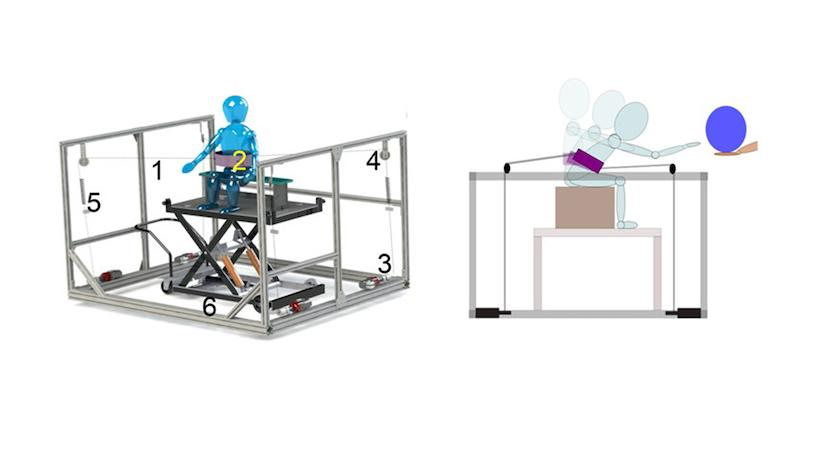Oct 23 2020
The most common physical disability found in children is cerebral palsy (CP)—2.0 to 3.5 per 1000 births—and children with CP at birth have impaired growth and reduced control of posture and movement.
 Trunk Support Trainer (TruST). Image Credit: Columbia University School of Engineering and Applied Science.
Trunk Support Trainer (TruST). Image Credit: Columbia University School of Engineering and Applied Science.
Specifically, children who have moderate to severe bilateral CP tend to have weak upper extremity abilities and segmental trunk control deficits, which restricts their independent functional sitting.
Several children with CP require wheelchairs to travel long distances, and a few need wheelchairs in a majority of the settings. A treatment developed to enhance their sitting control capabilities would considerably enhance their potential to function autonomously, live an active physical life, as well as take part in social activities.
At Columbia Engineering, scientists have developed a new robotic Trunk Support Trainer (TruST), which when integrated with an active practice of postural movements enhances trunk and achieving control in children with CP who have diminished sitting control.
The result holds well with their previous study on adults with spinal cord injury who could expand their sitting workspace with active support from TruST for their trunk movements.
Then, the researchers analyzed the usefulness of TruST for children with trunk control problems.
The team conducted a two-year longitudinal pilot study on four children aged between 6 and 14 years with CP and sitting control issues to analyze how TruST technology can be applied to offer a maximum amount of trunk support when the children are trained in games and activities.
Following the completion of TruST-intervention, the children exhibited improved short- and long-term postural and reaching control.
Mainly, the children were able to execute all the game-oriented activities without any help from a clinician, TruST, or supportive straps. The research has been published online recently in IEEE Transactions of Neural Systems and Rehabilitation Engineering.
According to Sunil Agrawal, professor of mechanical engineering and of rehabilitation and regenerative medicine, “The ability to control the trunk in sitting posture is pivotal for everyday functions such as sitting, feeding, and social interactions.”
Our Trunk Support Trainer, which we call TruST, is an innovative robotic device that helps physical therapists to not only support the children in the region of the trunk where they suffer from weakness and incoordination but also challenge them to perform rehabilitation tasks outside their base of support to improve their movement and coordination.
Sunil Agrawal, Professor of Mechanical Engineering and Rehabilitation and Regenerative Medicine, Columbia University School of Engineering and Applied Science
TruST is a motorized cable-driven belt worn around the trunk of the child and exerts active-assistive forces if the trunk moves past the postural stability limits.
Thus, TruST can offer personalized support for every child and can be decreased systematically as trunk control of children improves as part of the training.
TruST thus deals with postural-task progression in every training session by matching the assistive-force fields to the potential of each child to control the trunk in sitting. The concept is to support the child’s motor efforts if the trunk moves past the stability limits by adjusting the wire tensions.
TruST-intervention is robust, around two hours for every session, but completed over a comparatively short period spanning 12 training sessions. Children had to wear extra strapping near the waist to fasten their sitting position over the six initial training sessions.
But following the 6th session, children achieved a level of trunk control that enabled the team to eliminate the waist straps so they could sit by themselves for training purposes.
We wanted to scientifically demonstrate how robotic TruST can be used to deliver an intense activity-based postural and reaching training to improve the functional sitting abilities of children with CP and trunk control problems.
Victor Santamaria, Study First Author, Columbia University School of Engineering and Applied Science
Santamaria is also a physical therapist and associate researcher scientist in Agrawal’s Robotics and rehabilitation laboratory.
The latest developments in robotic equipment have allowed clinicians to handle repetition, intensity, and engagement for their patients to exercise task-oriented movements in CP.
A team under the guidance of Agrawal, in collaboration with other scientists at Teacher’s College and the Columbia University Irving Medical Center, recently obtained a five-year National Institutes of Health R01 award (#1R01 HD101903-01) to carry out a randomized clinical trial.
The project titled “Improving seated postural control and upper extremity function in bilateral CP with a robotic Trunk-Support-Trainer (TruST)” will include up to 80 children with poor trunk control.
A part of the children will make use of the TruST robotic rehabilitation while others will try traditional rehabilitation. The new NIH study will match the efficacy of the motorized TruST to occupy children in play-oriented practice while improving their skill advancement with static trunk support.
Our new NIH project is a randomized clinical trial with a large sample size to study the efficacy of TruST-intervention as a unique therapeutic solution to promote seated functional abilities in children with bilateral CP.
Sunil Agrawal, Professor of Mechanical Engineering and Rehabilitation and Regenerative Medicine, Columbia University School of Engineering and Applied Science
Seated Postural and Reaching Control Training with the Trunk Support Trainer (TruST)
The video shows the postural and reaching abilities of a child with CP. Before TruST-intervention the child showed severe trunk, control impairments and required pelvic strapping. After the completion of TruST-intervention, the child acquired the ability to perform the game while sitting without any external help. TruST is inactive and just used for measuring trunk control in this video. Video Credit: Victor Santamaria, Moiz Khan,Tatiana Luna/Columbia Engineering.
Journal Reference
Santamaria, V., et al. (2020) Promoting Functional and Independent Sitting in Children with Cerebral Palsy Using the Robotic Trunk Support Trainer. IEEE Transactions on Neural Systems and Rehabilitation Engineering. doi.org/10.1109/TNSRE.2020.3031580.